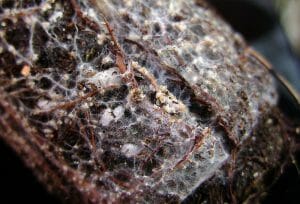Mycorrhizal fungi have a symbiotic relationship with the root system of a vascular host plant. These fungi cover and sometimes invade the plant’s roots which allows them to exchange nutrients. The benefits the fungi give to plants include solubilizing phosphorous and bringing soil nutrients like nitrogen, phosphorous, micronutrients and water to them. In trade, the plant provides the fungi with a constant supply of carbohydrates like glucose and fructose. Mycorrhizal fungi that colonize on the surface of roots belong to the group ectomycorrhizae and are found on the roots of trees. Endomycorrhizae fungi grow inside the cells of the roots and are found with vegetables, shrubs and grasses.

The image above shows mycorrhizal fungi (white) growing on and around a root system.
References
- Ingham, E.R. (n.d.). The living soil: Fungi. Retrieved December 27, 2017 from https://www.nrcs.usda.gov/wps/portal/nrcs/detailfull/soils/health/biology/?cid=nrcs142p2_053864
